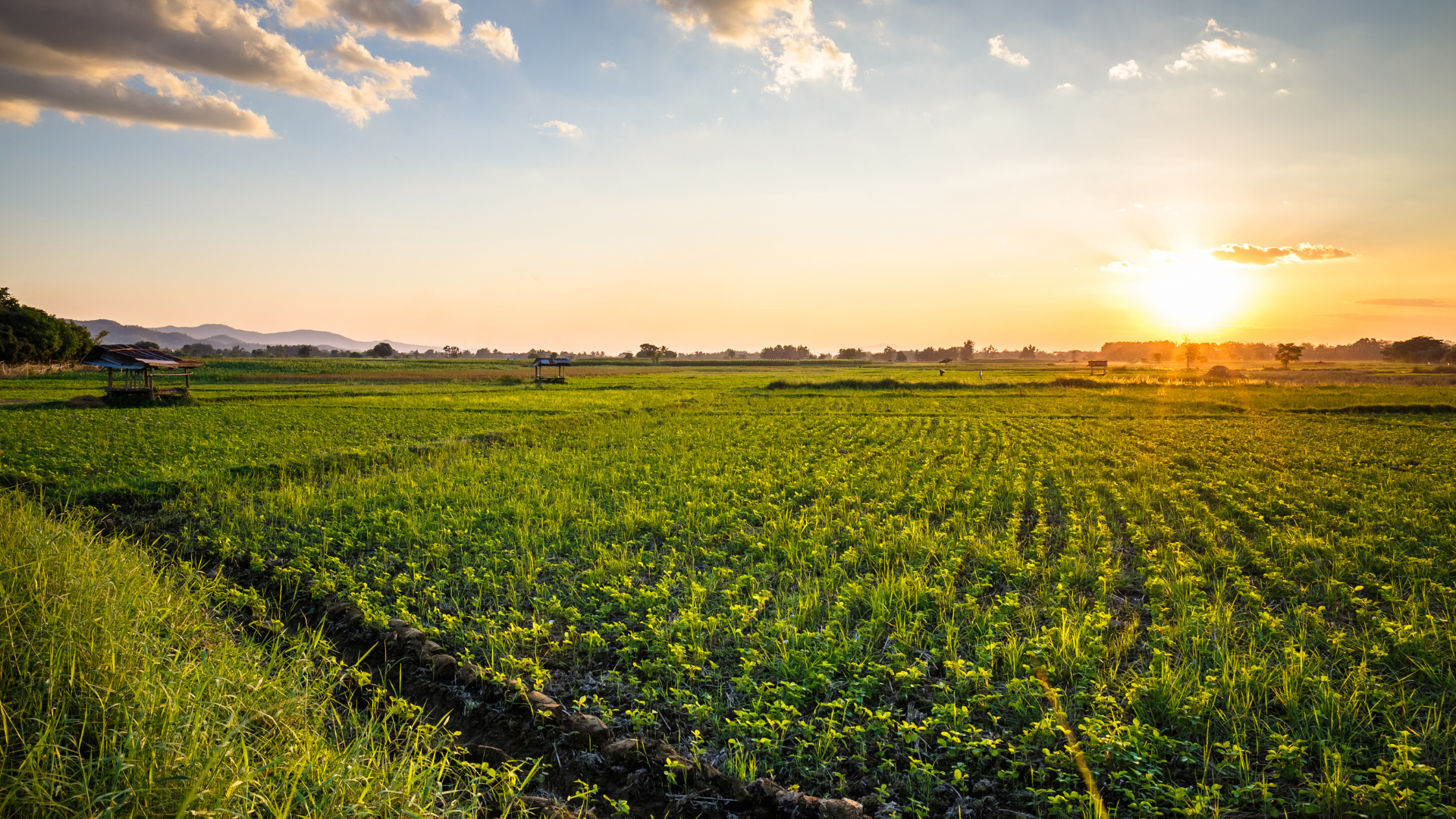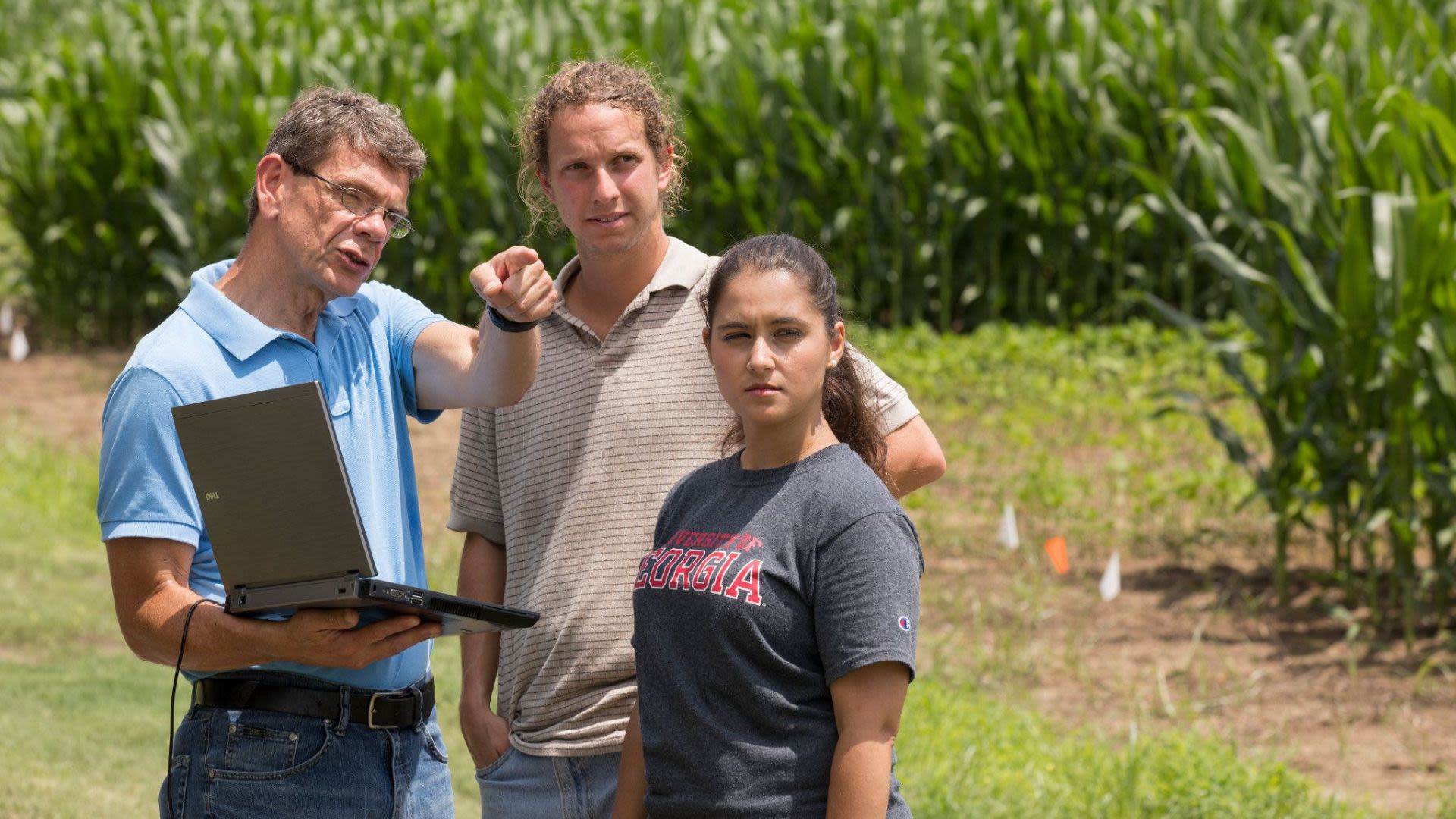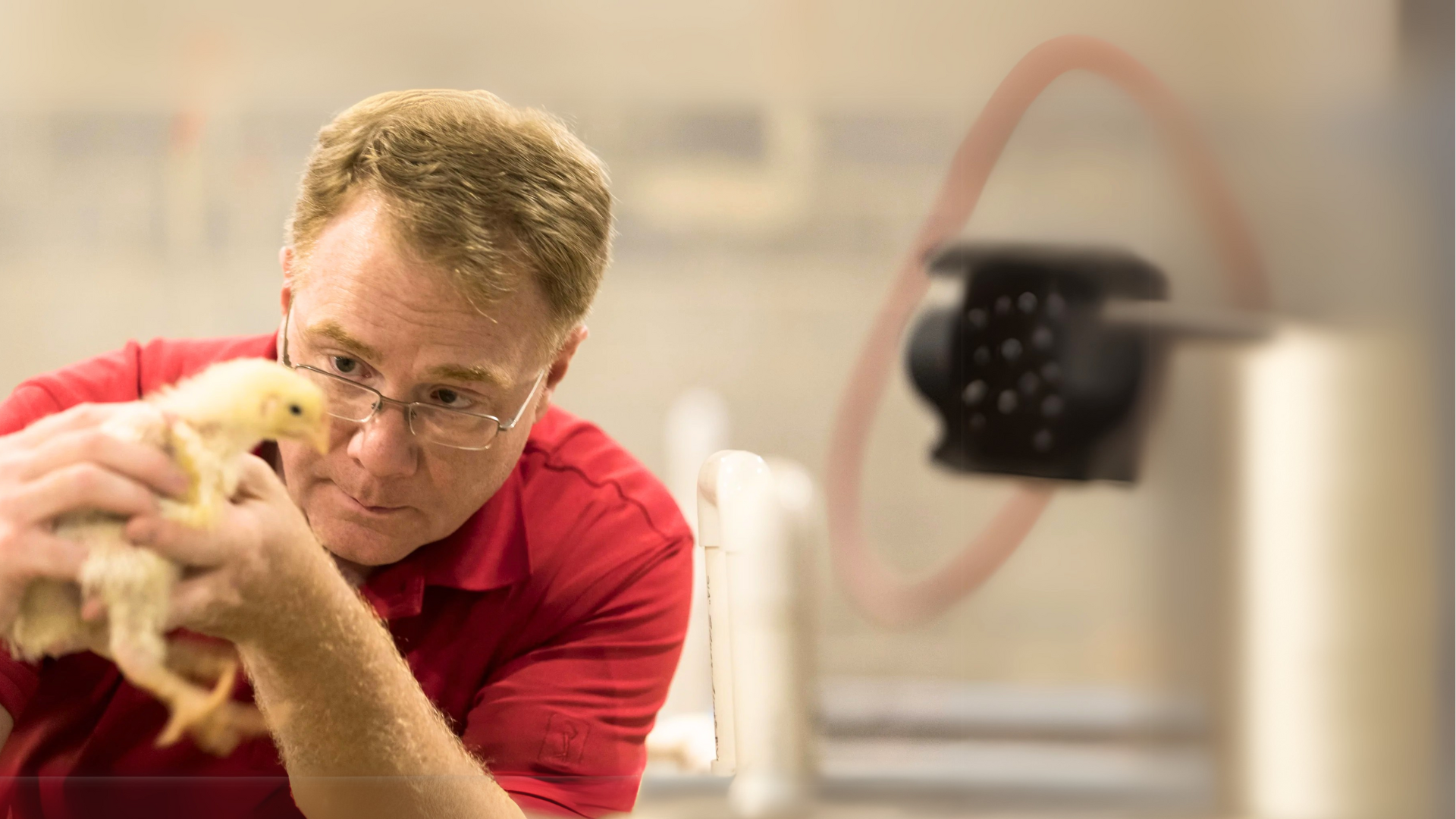Insights for legislators
Georgia Ag Impact Report
The Georgia Ag Impact Report provides the state's agricultural stakeholders the research-backed insights they need to support Georgia’s No. 1 industry. As a national leader in agricultural innovation and outreach, the University of Georgia College of Agricultural and Environmental Sciences (CAES) is proud to empower producers with innovative research to cultivate a stronger, healthier Georgia.

Insights for legislators
Georgia Ag Impact Report
The Georgia Ag Impact Report provides the state's agricultural stakeholders the research-backed insights they need to support Georgia’s No. 1 industry. As a national leader in agricultural innovation and outreach, the University of Georgia College of Agricultural and Environmental Sciences (CAES) is proud to empower producers with innovative research to cultivate a stronger, healthier Georgia.

The College of Agricultural and Environmental Sciences (CAES) is proud to share the Georgia Ag Impact Report, a report designed from our Ag Forecast data to provide an in-depth look at the opportunities and trends shaping Georgia’s agricultural sector.
Developed by the expert economists at CAES, this report offers valuable insights into the current and future landscape of agriculture in our state. It highlights the factors driving growth, as well as the areas where strategic investments can make a meaningful impact.
As key decision-makers and citizens of our great state, you play a critical role in shaping the future of agriculture in Georgia. This report provides the tools needed to make informed decisions that will benefit farmers, producers and the state’s economy as a whole. Together, we can work to ensure a bright future for agriculture in Georgia.
Sincerely,
Nick T. Place, PhD
Dean and Director
UGA College of Agricultural and Environmental Sciences

Economic outlook
The 2023 Georgia Farm Gate Value is $17,608,944,181.
The 2025 Georgia Ag Impact Report data is based on the 2023 Georgia Farm Gate Value Report, an annual county-level economic valuation for all food and fiber production in the state.
In 2023, food and fiber production and related industries represented $91.4 billion in output to Georgia’s $1.4 trillion economy and more than 381,200 jobs statewide.
Key takeaways: U.S. and Georgia
- 2025 economic forecast for Georgia calls for an economic slowdown, but not a recession. We estimate the probability of recession at 25%.
- Georgia’s economy will grow faster than the nation’s economy because of recent economic development success, stronger demographics, and favorable economic structure.
- The unemployment rate is expected to rise, but not too much. The rise in the unemployment rate will mostly reflect less hiring rather than more layoffs.
- Inflation fell to 3% in 2024, but it will not fall further in 2025.
- In terms of economic severity, the main downside risks to growth are a mistake by the Federal Reserve, a financial crisis, an energy price shock, a federal policy mistake, and a stock market correction.
Key takeaways: Georgia agriculture
- Food price growth in 2025 is projected to align with inflation at around 2.5%.
- Prices for food consumed away from home are expected to remain higher than those for food consumed at home.
- Commodity prices are forecast to trend downward in the near term, with stability anticipated in the medium term.
- According to the most recent USDA farm income forecast, declining crop prices are expected to outweigh revenue gains from animal products, combined with slightly reduced input costs, leading to lower national net farm income in 2024.
- USDA projections indicate a decline in net farm income of 4.1% in nominal terms and 6.3% in inflation-adjusted terms nationally in 2024. However, these projections will not apply to Georgia because of the significant damages caused by Hurricane Helene, which resulted in lost output and infrastructure.
- Looking forward to 2025 and beyond, numerous geopolitical risks combined with various proposed policies—including tariffs and retaliation, immigration controls, tax policies, energy strategies, and inflation-targeted monetary policies—contribute to ongoing uncertainties surrounding U.S. and Georgia agricultural economic outcomes.
For more insights and key takeaways, please visit the 2025 Georgia Ag Forecast annual publication.
The Georgia Ag Forecast is an annual seminar hosted by CAES sharing the latest research and information from CAES faculty to help Georgia farmers and agribusinesses prepare for their year ahead.
Economic outlook
The 2023 Georgia Farm Gate Value is $17,608,944,181.
The 2025 Georgia Ag Impact Report data is based on the 2023 Georgia Farm Gate Value Report, an annual county-level economic valuation for all food and fiber production in the state.
In 2023, food and fiber production and related industries represented $91.4 billion in output to Georgia’s $1.4 trillion economy and more than 381,200 jobs statewide.
Key takeaways: U.S. and Georgia
- 2025 economic forecast for Georgia calls for an economic slowdown, but not a recession. We estimate the probability of recession at 25%.
- Georgia’s economy will grow faster than the nation’s economy because of recent economic development success, stronger demographics, and favorable economic structure.
- The unemployment rate is expected to rise, but not too much. The rise in the unemployment rate will mostly reflect less hiring rather than more layoffs.
- Inflation fell to 3% in 2024, but it will not fall further in 2025.
- In terms of economic severity, the main downside risks to growth are a mistake by the Federal Reserve, a financial crisis, an energy price shock, a federal policy mistake, and a stock market correction.
Key takeaways: Georgia agriculture
- Food price growth in 2025 is projected to align with inflation at around 2.5%.
- Prices for food consumed away from home are expected to remain higher than those for food consumed at home.
- Commodity prices are forecast to trend downward in the near term, with stability anticipated in the medium term.
- According to the most recent USDA farm income forecast, declining crop prices are expected to outweigh revenue gains from animal products, combined with slightly reduced input costs, leading to lower national net farm income in 2024.
- USDA projections indicate a decline in net farm income of 4.1% in nominal terms and 6.3% in inflation-adjusted terms nationally in 2024. However, these projections will not apply to Georgia because of the significant damages caused by Hurricane Helene, which resulted in lost output and infrastructure.
- Looking forward to 2025 and beyond, numerous geopolitical risks combined with various proposed policies—including tariffs and retaliation, immigration controls, tax policies, energy strategies, and inflation-targeted monetary policies—contribute to ongoing uncertainties surrounding U.S. and Georgia agricultural economic outcomes.
For more insights and key takeaways, please visit the 2025 Georgia Ag Forecast annual publication.
The Georgia Ag Forecast is an annual seminar hosted by CAES sharing the latest research and information from CAES faculty to help Georgia farmers and agribusinesses prepare for their year ahead.

Top 10 commodities:
1. Broilers: $5.8 billion | 33% of the total farm gate value
2. Eggs: $988 million | 5.6% of the total farm gate value
3. Beef: $981.7 million | 5.6% of the total farm gate value
4. Cotton: $938.6 million | 5.3% of the total farm gate value
5. Peanuts: $915 million | 5.2% of the total farm gate value
6. Timber: $885.8 million | 5% of the total farm gate value
7. Greenhouse: $585 million | 3.3% of the total farm gate value
8. Blueberries: $526.6 million | 3% of the total farm gate value
9. Corn: $514 million | 2.9% of the total farm gate value
10. Dairy: $456.1 million | 2.6% of the total farm gate value
Top 10 vegetables:
- Watermelons: $196.3 million | 14.7% of the total farm gate value
- Onions: $187.1 million | 14% of the total farm gate value
- Sweet corn: $174.7 million | 13.1% of the total farm gate value
- Bell peppers: $138.6 million | 10.4% of the total farm gate value
- Tomatoes: $90.5 million | 6.8% of the total farm gate value
- Cucumbers: $78.1 million | 5.9% of the total farm gate value
- Yellow squash: $43 million | 3.2% of the total farm gate value
- Cabbage: $38.4 million | 2.9% of the total farm gate value
- Zucchini: $36.5 million | 2.7% of the total farm gate value
- Carrots: $30.6 million | 2.3% of the total farm gate value

Commodity-specific insights
Poultry and eggs
Poultry and eggs contributed $29.7 billion to the statewide economy and represented 89,974 jobs in Georgia. Nearly 75% of Georgia counties are involved in poultry and egg production.
Distribution:
- Broilers: 83.9%
- Hatching eggs: 7.7%
- Table eggs: 6.6%
- Pullets: 1.8%
- Quail and miscellaneous: .1%
Top county producers:
- Hart: $530,937,670 | 7.66% of the total farm gate value
- Franklin: $512,913,571 | 7.40% of the total farm gate value
- Madison: $380,425,454 | 5.49% of the total farm gate value
Row and forage crops
Row and forage crops contributed $19.4 billion to the statewide economy and represented 69,857 jobs in Georgia. In 2023, Georgia produced more than one-half of the nation's peanuts.
Distribution:
- Cotton: 30.2%
- Peanuts: 29.4%
- Corn: 16.5%
- Hay: 11.9%
- Soybeans: 3.4%
Top county producers:
- Mitchell: $123,513,580 | 3.97% of the total farm gate value
- Dooly: $103,058,996 | 3.31% of the total farm gate value
- Worth: $97,052,130 | 3.12% of the total farm gate value
Livestock and aquaculture
Livestock and aquaculture contributed $12.1 billion to the statewide economy and represented 47,675 jobs in Georgia.
Distribution:
- Beef cows: 39.8%
- Dairy: 23.6%
- Horses, boarding, training and breeding: 10.5%
- Beef stockers: 6.6%
- Honeybees: 4.3%
Top county producers:
- Macon: $115,980,938 | 5.99% of the total farm gate value
- Burke: $88,902,024 | 4.59% of the total farm gate value
- Oglethorpe: $78,704,130 | 4.07% of the total farm gate value
Ornamental horticulture
Ornamental horticulture contributed $11.1 billion to the statewide economy and represented 73,801 jobs in Georgia.
Distribution:
- Greenhouse: 43.4%
- Turfgrass: 17.9%
- Field nursery: 17.9%
- Container nursery: 15.8%
- Other: 4.9%
Top county producers:
- Gwinnett: $113,550,000 | 8.43% of the total farm gate value
- Columbia: $107,526,460 | 7.99% of the total farm gate value
- McDuffie: $65,218,552 | 4.84% of the total farm gate value
Vegetables
Vegetables contributed $3.1 billion to the statewide economy and represented 17,220 jobs in Georgia.
Distribution:
- Watermelons: 14.7%
- Onions: 14%
- Sweet corn: 13.1%
- Bell peppers: 10.4%
- Tomatoes: 6.8%
Top county producers:
- Colquitt: $215,155,540 | 16.14% of the total farm gate value
- Decatur: $119,426,100 | 8.96% of the total farm gate value
- Echols: $117,146,500 | 8.79% of the total farm gate value
Fruits and nuts
Fruits and nuts contributed $4.2 billion to the statewide economy and represented 29,327 jobs in Georgia.
Distribution:
- Blueberries: 47.5%
- Pecans: 31.8%
- Grapes: 4.5%
- Citrus: 3.5%
- Peaches: 1.9%
Top county producers:
- Bacon: $124,651,378 | 11.23% of the total farm gate value
- Baker: $102,220,596 | 9.21% of the total farm gate value
- Appling: $74,708,400 | 6.73% of the total farm gate value
Forestry and products
Forestry and products contributed $1.06 billion to the statewide economy and represented 56,945 jobs in Georgia.
Distribution:
- Timber: 83.5%
- Pine straw: 9.4%
- Other forestry: 6.3%
- Christmas trees: .9%
Top county producers:
- Laurens: $34,280,727 | 3.23% of the total farm gate value
- Wayne: $32,691,173 | 3.08% of the total farm gate value
- Emanuel: $32,496,977 | 3.06% of the total farm gate value
Agritourism and hunting leases
Agritourism and hunting leases contributed $212 million. In 2023, agriculture and related industries contributed $91.4 billion in output to Georgia’s $1.4 trillion economy.
Distribution:
- Agriculture- and nature-based tourism: 55.7%
- Hunting leases (deer): 32.2%
- Hunting leases (turkey): 11%
- Hunting leases (duck): 1.1%
Top county producers:
- Cherokee: $11,230,000 | 9.51% of the total farm gate value
- Gilmer: $7,595,079 | 6.43% of the total farm gate value
- Toombs: $7,500,000 | 6.35% of the total farm gate value

County- and district-level data
|
2023 top 10 counties by total farm gate value |
||
|---|---|---|
|
County |
Total farm gate value |
Percentage of total |
|
Colquitt |
$635,319,928 |
3.61% |
|
Hart |
$629,348,091 |
3.57% |
|
Franklin |
$546,721,300 |
3.10% |
|
Tattnall |
$464,112,906 |
2.64% |
|
Mitchell |
$447,757,048 |
2.54% |
|
Madison |
$439,050,787 |
2.49 |
|
Macon |
$390,213,443 |
2.22% |
|
Coffee |
$377,344,044 |
2.14% |
|
Oglethorpe |
$375,752,892 |
2.13% |
|
Gordon |
$356,822,450 |
2.03% |
|
2023 total farm gate value U.S. Congressional District |
|
|---|---|
|
District |
Total farm gate value |
|
District 1 |
$2,633,625,945 |
|
District 2 |
$4,190,033,197 |
|
District 3 |
$614,640,766 |
|
District 4 |
$151,202,821 |
|
District 5 |
$57,511,306 |
|
District 6 |
$115,852,101 |
|
District 7 |
$370,950,459 |
|
District 8 |
$2,301,515,828 |
|
District 9 |
$1,611,182,458 |
|
District 10 |
$3,936,285,046 |
|
District 11 |
$1,049,281,194 |
|
District 12 |
$1,864,068,490 |
|
District 13 |
$91,502,614 |
|
2023 total farm gate value by Cooperative Extension district |
||
|---|---|---|
|
District |
Total farm gate value |
Percentage of total |
|
Northeast |
$5,144,202,772 |
29.21% |
|
Northwest |
$2,389,327,647 |
13.57% |
|
Southeast |
$3,935,327,904 |
22.35% |
|
Southwest |
$6,140,085,859 |
34.87% |
View data by year, county or commodity
The Georgia Farm Gate Value Report is an annual, county-level economic valuation of food and fiber production in the state. The numbers in this report are estimated by local county UGA Cooperative Extension agents and refined by data analysts from the CAES Department of Agricultural and Applied Economics. This report was last reviewed January 2025.
For best functionality, view on desktop. To expand this visualization, select the full-screen icon in the bottom right corner. Click the three dots icon on mobile.

Agriculture supports many other Georgia industries.
In terms of employment:
- Truck transportation: 10,426 employed
- Other nondurable goods wholesalers: 4,995 employed
- Warehousing and storage: 4,157 employed
- Couriers and messengers: 4,107 employed
- Employment services: 3,849 employed
- Other real estate: 3,388 employed
- Management of companies and enterprises: 3,186 employed
- Grocery and related product wholesalers: 2,757 employed
- Other durable goods merchant wholesalers: 2,186 employed
- Scenic and sightseeing transprotation and support activities: 1,781 employed
Together, Georgia commodities directly represent a value of over $17.6 billion to the state's economy. In 2023, food and fiber production and related industries contributed $91.4 billion in output to Georgia’s $1.4 trillion economy and more than 381,200 jobs.
The University of Georgia's College of Agricultural and Environmental (CAES) serves Georgians by showcasing and communicating the most up-to-date and relevant agricultural and economic information for Georgia's No. 1 industry: agriculture.
As Georgia's land-grant university, CAES conducts cutting-edge research on critical and emerging issues that are important to the agriculture industry. From this research, CAES provides the best information and education available to producers and constituents to equip them with knowledge and decision-making tools for their businesses.
We need your continued support so Georgia can continue to be a leader in agriculture and environmental sciences to create a healthier and more prosperous Georgia.





















